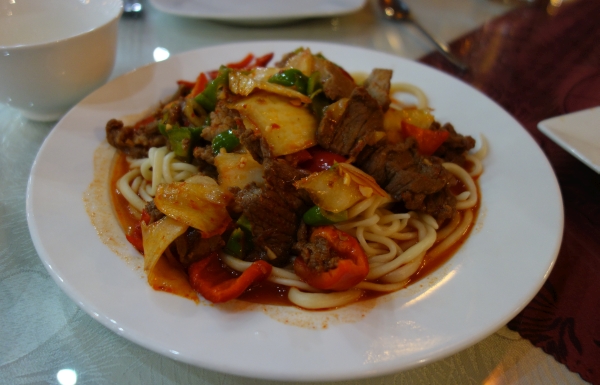I’ve returned from a 2-week trip to Central Asia! I spent a week in Uzbekistan and a week in Kyrgyzstan, eating some of the foods I write about on this blog. Prior to this trip, it had been 8 years since I was last in Central Asia (in Xinjiang) so it was good to eat some old favorites and try some new foods.
Plov
Uzbekistan is the motherland of plov and it did not disappoint in this regard! I ate plov in every city I visited – Khiva, Samarkand, Bukhara. Each region has its own plov variety, which I found really interesting as there is basically only one variant of plov(or “polo”) in Xinjiang. The Uzbek plov was generally oilier than mine, and their rice grain is different. I had been using basmati, but in Uzbekistan they use a thicker, rounder grain of rice, almost like risotto or Japanese sushi rice. Here’s my plov recipe.
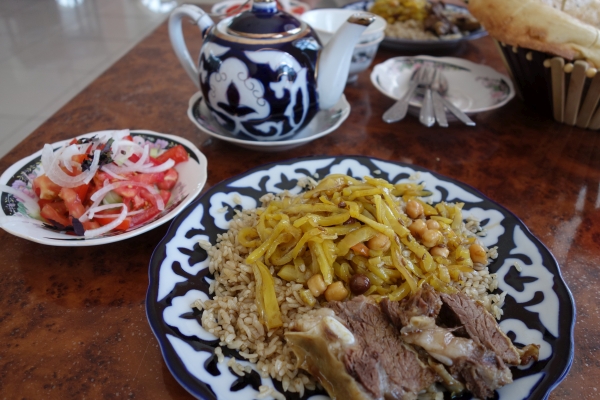
Plov in Samarkand. Note the chickpeas and how all the elements (rice, carrots, meat) are separate.

Plov in Khiva. Note how the rice is all white.
Laghman
Finally, to eat laghman made by someone other than myself! While Indian biryani or even Turkish pilaf has some resemblance to plov, there’s basically nothing like laghman to be found in the West. I keep cooking and cooking laghman at home, and after 8 years away from Central Asia, sometimes began to wonder if anyone else on earth eats this dish. Here is my Uyghur lagman recipe.

Uyghur-style laghman at Chinar restaurant in Bukhara

Kovurma laghman at Besh Chinor restaurant in Samarkand
The traditional Uzbek lagman is more like a noodle soup with all sorts of vegetables and potatoes in it. It’s often flavored with dill. However, they do have other varieties of lagman like “kovurma lagman”, which resembles the Uyghur version (noodles with a sauce on top), and many restaurants sell Uyghur-style laghman as well. I personally much prefer my laghman with a sauce topping rather than in a soup.

Guiru laghman at an Uyghur restaurant in Osh.
I was pleasantly surprised by the food in Kyrgyzstan, at least in the cities. While the traditional Kyrgyz food might not be that exciting, due to their location in between Uzbekistan and China they have some great restaurants serving Uzbek, Uyghur, and Dungan cuisine. The laghman was great, and actually surprisingly similar to the one I cook at home. Of course, since my own recipe comes from an Uyghur chef from Bishkek, perhaps it’s not so surprising.
Manti
A staple of our travels! This is one dish I rarely make at home because it’s just so time consuming; plus it’s easy to just buy frozen dumplings from the Chinese grocery even if they aren’t the same thing. But Central Asian manti are really quite special, especially with some yogurt sauce. Chuchvara soup is even more time consuming; I admit I’ve only done it myself once because it takes so long to fold all those tiny dumplings. Here is my manti recipe.


Meat
In Kyrgyzstan I ate a dish called “kuurdak” which is very similar to “kazan kebab”(I haven’t posted the recipe yet). Basically roasted meat with potatoes. It’s rather oily, but very tasty.
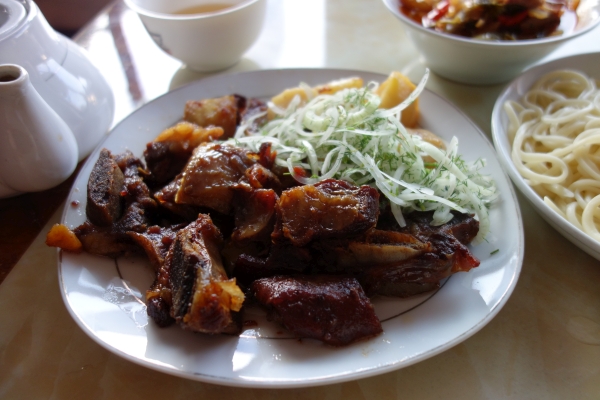
Kuurdak at an Uyghur restaurant in Osh.
I also ate plenty of shashlik/kebabs in Uzbekistan. Here’s a meal from a rest stop in the middle of the Kyzyl Kum desert on the road from Khiva to Bukhara. For being in the middle of a desert, they had surprisingly good food.
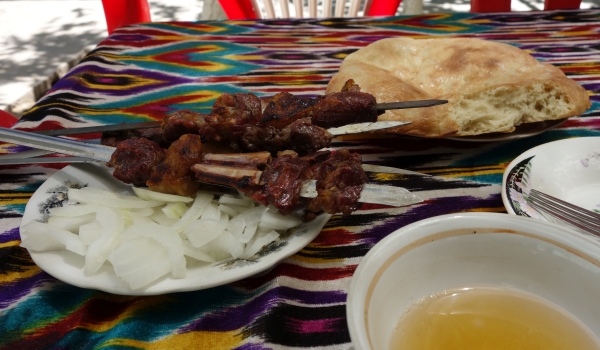 Shashlik lunch at a rest stop in the Kyzyl Kum desert
Shashlik lunch at a rest stop in the Kyzyl Kum desert

Shashlik at Besh Chinor restaurant in Samarkand

On the left, “hasip”, a type of Uzbek sausage; on the right, “naryn”, cold noodles with horse meat. At “Miliy taomlar”(National foods) in Tashkent.
Bread
In Uzbekistan they generally make a big, puffy, round sort of bread as opposed to the flat disc-shaped bread you see in Xinjiang. I bought myself some Uzbek bread stamps in Samarkand – a cooking tool almost impossible to find in the West, though you can order one at quite some cost from China – details in my nan bread recipe. I found them in the Siyob bazaar in Samarkand, sold for 10,000 som each (around $2.50 USD). Not really a common tourist souvenir so may be hard to find outside of a bazaar, although I remember seeing them being sold in Khiva as well.

Beautiful bread bought from Samarkand’s Siyob bazaar.
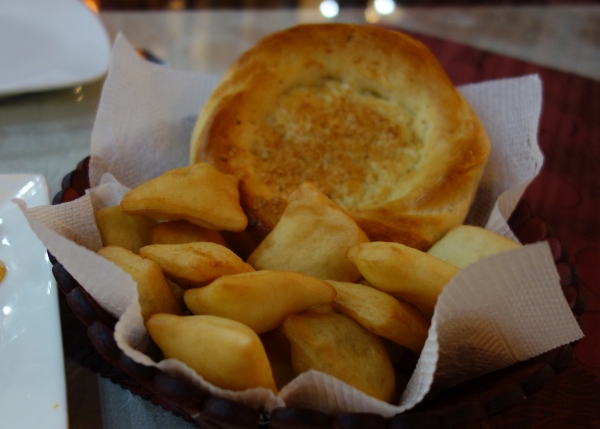
In Kyrgyzstan, they served a type of bread called “boor sok.” It’s little pockets of frybread, not unlike sopapillas. Very tasty. I’ll have to try making them at home.
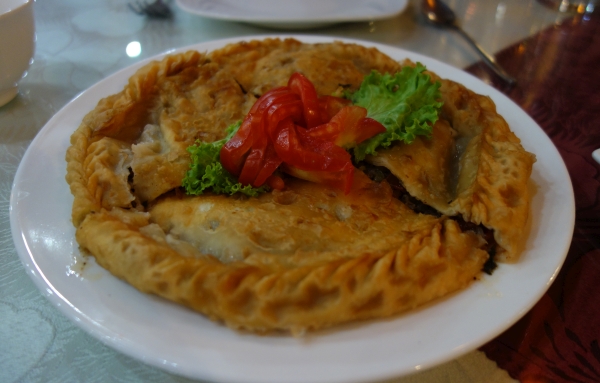
Gosh nan or Uyghur meat pie. Here’s my recipe.
Cold dishes/appetizers
At every meal, some type of salad was served, usually with the bread. Typically a simple salad from tomatoes, cucumbers, and onions, and a pinch of salt, but sometimes flavored with some fresh herbs too. You can see the little salad in most of the pictures above.

Ashlyanfu at Arzu restaurant in Bishkek
I also got to try “Ashlyanfu”, which comes from Dungans (Chinese Central Asians). It’s a cold noodle soup with wheat noodles and mung bean jelly noodles. Sounds strange, but very good. I’ve yet to try making this one at home, maybe because it seems rather labor intensive (making the jelly noodles). In mainland China, they eat something similar called “liang pi”; I eat it sometimes at the Chinese places near my home.
Naturally, green tea was served at every meal. Unlike in Xinjiang where people “wash” the tea bowls with some hot tea and then throw it out, in Uzbekistan they pour some tea into a bowl and then pour it back into the pot, sometimes multiple times. I picked up my own Uzbek teapot and tea bowls. They were selling all sorts of fancy elaborate porcelain in the tourist shops, but I really just wanted the same exact blue and white teapot that appears in almost every restaurant in Uzbekistan (it makes an appearance in a few of the pictures above). Luckily I found them in Siyob bazaar in Samarkand for cheap – a teapot and four bowls was around 25,000 som or $6 USD.
Hope you enjoyed the photos – I’ll try to get back to posting recipes soon.


